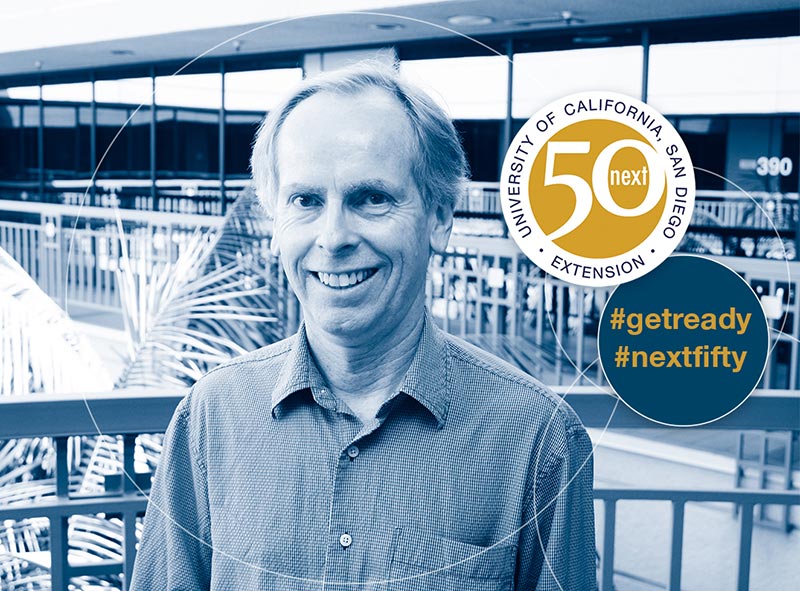
In honor of UC San Diego Extension's first 50 years, 50 Voices of the Future asks thought leaders about the trends, breakthroughs and social advances they foresee over the next 50 years.
The bad news is that Americans are heavier than ever. The good news, says UC San Diego’s Dr. James Sallis, is they’re gaining weight at a slower pace than they were only a few years ago. As one of the country’s leading advocates of active and healthy lifestyles, Sallis will take small victories where he can find them.
Sallis, chief of UC San Diego’s Division of Behavioral Medicine in the Department of Family Medicine and Public Health, spends much of his professional life preaching the benefits of physical activity as a means of reducing obesity and all its associated health risks. He thinks we’ve reached something of a turning point in this country. A few decades from now, he predicts, Americans will be a more slender group, in part because our future cities will be much more walkable and less car-dependent. Still, much work must be done. “Physical inactivity,” he says, “is one of the scourges of the 21st century.”
(1) Why is the work you do important?
Physical inactivity is one of the fourth or fifth leading causes of death in the U.S. and internationally and it’s estimated to be responsible for about 5 million deaths globally every year. It contributes to so many chronic diseases that kill people and interfere with their quality of life. It’s definitely one of the biggest health challenges that we have. We’re working on a very important problem and we’re trying to come up with solutions that are going to be helpful to as many people as possible. So that’s what keeps me going.
(2) What are the influential/exciting developments happening in your field now and why?
Our research shows that the way we are building our cities is having a devastating impact on physical activity. The vast acreage that we’ve devoted to suburbanization over the past 50 years – everything is too far away from everything else to walk. The big trend is for public health to get engaged with non-health groups – city planning, transportation and also education for physical education and recess and walking to school, getting more involved with the parks and recreation sector to make sure that people have parks nearby and that those parks are designed for physical activity.
Also, most people know they’re eating too much. Most people know they’re eating a lot of unhealthy foods. And most people want to eat better. So we’re making progress from the awareness and intention side. But we’re making limited progress in helping people actually improve their diets. Just wanting to reduce eating fat and sugar doesn’t mean that it’s easy. We now understand the challenges of a food supply that provides cheap and appetizing foods everywhere that are too unhealthy. We are starting to work on ensuring that everyone has good access to more affordable healthier foods.
(3) What’s the next big thing?
We need to get more people walking and biking. It’s a critically important global agenda. We’re also finding there’s a market demand for walkable neighborhoods. That’s being driven by demographic trends. Millennials don’t want to live in the suburbs; they don’t want to be dependent on their cars. Many young people are not even bothering to get driver’s licenses. They want to live in places like downtown San Diego. We are studying the economics of this to convince decision-makers in government and also real-estate developers--hey, you can make more money building healthier places.
(4) How big an impact will your field play in shaping the future of the San Diego region and beyond?
Right now, it looks like we can play a modest to moderate role. San Diego City Council very recently adopted a Climate Action Plan. One of the pillars of that is getting many more people walking and biking. That’s a big change for San Diego.
(5) Hop into your time machine…what does the future look like for this field in 50 years? How can individuals/companies get prepared for what’s next?
I think that’s enough time for us to change the trajectory of a lot of these trends. In 50 years I would expect that almost all new development in the U.S. is going to be activity-friendly–safe and convenient for walking and biking and public transit. That will certainly be consistent with improving health. Also, the threatened implosion of our healthcare system at some point due to common expensive diseases like type 2 diabetes is going to stimulate really major societal changes, both on the physical activity side and the food side.
Discover the wide variety of related Healthcare and Environment & Sustainability courses and programs offered through UC San Diego Extension, including Urban Planning and Preservation, Sustainability & Behavior Change, Sustainable Business Practices, Counseling & Behavioral Sciences and Fitness Instruction/Exercise Science.